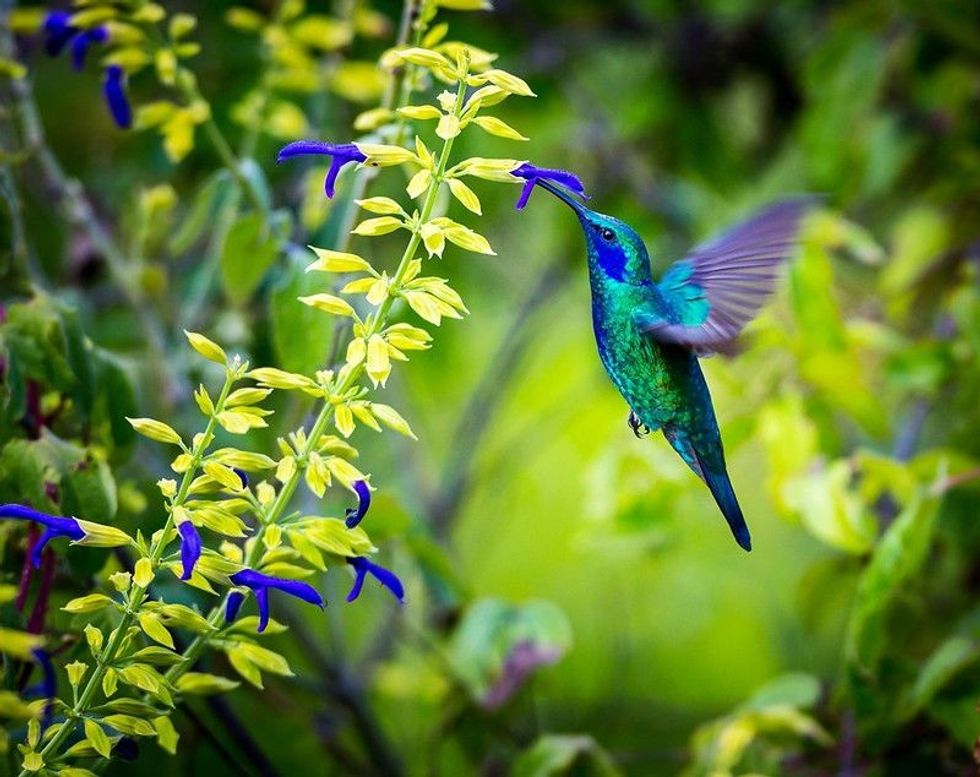Hummingbirds are stunning birds found in North and South America.
There are lots of special features about hummingbirds. However, their small size, beautiful plumage, and flying patterns are what grabs the most attention.
There are over 300 species of hummingbirds distributed over 113-115 genera. Needless to say, each of these species holds some form of brilliance of their own.
So, most bird-watchers are more than eager to catch a glimpse of these birds. While some hummingbirds are common, some are rare.
However, without knowing the right time or season, it could be difficult to catch sight of either kind of hummingbird. Most hummingbirds are known to migrate to southern regions to spend the winter season. They start the migration towards their wintering ground right before fall.
The migration towards the north occurs in spring or summer. Even though hummingbirds are not associated with winter, they do come out to feed during these seasons.
A helpful guide is certainly required before you set out to see these beautiful birds in the wild or right in your own backyard around hummingbird feeders.
If you enjoyed this article, why not also read about why do hummingbirds fight and why do parrots talk here on Kidadl?
Best Seasons For Hummingbird Sightings
The hummingbird migration season varies from species to species, in the United States of America. However, in general, most hummingbirds migrate between February and March to their breeding grounds.
Hence, their time of arrival in the various states of the United States is during early spring or summer, from early March to April and May. There are a few exceptions, in terms of hummingbird species that are found year-round, like Anna's hummingbird.
In the states of Alabama and Alaska, the arrival of hummingbirds occurs in late April or early May. While in Alabama, 12 different species of hummingbirds have been observed, in Alaska, the rufous hummingbirds remain the most common, followed by Anna's hummingbirds and Costa's hummingbirds.
In Arizona, early April marks the season of arrival of a variety of hummingbirds. In South Carolina and Texas, the birds are observed in mid-March or year-round, and mid-March or April, respectively.
The ruby-throated hummingbirds are known to frequent South Carolina and are sometimes observed throughout the year. In Texas, there are quite a few migratory hummingbirds, ranging across a wide number of species.
Two examples of them are black-chinned hummingbirds and blue-throated hummingbirds. In both North and South Dakota, hummingbirds are quite rare.
The ruby-throated hummingbirds are the only hummingbirds whose migration route includes these two states. While in North Dakota, early spring and late summer are favorable seasons for catching a glimpse of the rufous hummingbirds, in South Dakota, mid-May will be your best bet.
Hence, putting out hummingbird feeders during the months of March, April, and May will certainly aid in hummingbird feeding.
Types Of Hummingbirds In North America
There are at least 20 species of hummingbirds seen in North America. These hummingbirds might have distinct geographical ranges or even overlapping ones.
Ruby-throated hummingbird: the ruby-throated hummingbird is primarily found along the eastern region of North America. It spends its winter in Mexico and a few other places in the south. However, the breeding grounds of these birds are up north, where these birds migrate to in the spring season.
Rufous hummingbird: the rufous hummingbird is found along the western part of North America. While breeding occurs in places like Alaska, California, and British Columbia, wintering is carried out in Mexico.
Black-chinned hummingbird: the black-chinned hummingbird is similar to the broad-tailed hummingbird and rufous hummingbird. Just like the rufous hummingbirds, these birds are also found in the western region.
The majority of these hummingbirds are known to arrive in Texas and Mexico to spend the winter season. Their breeding range is quite extensive and includes New Mexico, northern and southern California, along with several parts of Mexico and Texas, among other places.
Anna's hummingbird: this hummingbird is one of the species with a year-round presence. Regions, where they are found all year round, are in parts of Texas, Nevada, Utah, and so on. However, some populations are known to migrate south to spend the winter seasons. Additionally, vagrant birds have been seen throughout the United States, in fall or early winter.
Most Active Time Of The Day For Hummingbirds

Hummingbirds are diurnal birds, meaning most of their activities are carried out during the daytime. So, hummingbirds have been observed to fly around and gather near food sources or hummingbird feeders during this time.
During dawn, hummingbirds remain the busiest. This is the time when they gather in large numbers around hummingbird feeders. After a long night, the hummingbirds arrive at food sources to replenish their energy for the day ahead.
As dawn rolls into daytime and afternoon, these birds will still be relatively active around the hummingbird feeders. Given their high metabolism, hummingbirds need to feed five to eight times every hour! For bird-watchers, this time of the day is the most ideal to spot hummingbirds hovering and eating their food.
Your Chances Of Sighting Hummingbirds At Night
Hummingbirds remain quite active throughout the day. Hence, these birds need a good night's rest. In general, hummingbirds are not very active at night and are usually found to be sleeping.
Right before daylight is about to end, hummingbirds start preparing themselves in order to rest. Interestingly, hummingbirds go into a state of hibernation every night. This state is known as torpor.
Torpor in these birds is characterized by decreased heart rate, respiratory rate, and body temperature. In fact, if you stumble upon a hummingbird, while it's in torpor, you might think the bird is dead. It takes a hummingbird nearly 20 minutes in warm weather or an hour in the winter to come out of torpor, with daybreak.
That being said, it is not completely uncommon to see hummingbirds at night. At times, these birds do come out for feeding. You might also find these birds foraging for insects. Artificial lighting at night may also encourage hummingbirds to keep feeding.
Hence, they do not just come out when there is sunshine. Additionally, some hummingbirds migrate very long distances, which can continue throughout the day and night. For instance, the ruby-throated hummingbirds take 20 hours to cross the Gulf of Mexico, without any resting stops in between.
Guide To Hummingbird Feeding Times
Being diurnal birds, hummingbirds are mostly seen feeding during the daytime. The most active period of eating occurs at dawn. However, varying levels of food collection occur throughout the day.
If you are confused about when to put out a hummingbird feeder in your backyard, the best solution is to keep the feeders present at all times. While most hummingbirds arrive bright and early in the morning to eat their food, they remain active throughout the day (and sometimes night) and are very commonly seen around their feeders.
Given the high metabolism of these birds, it is quite natural for them to feed pretty often.
If you are going out bird-watching, you might certainly get to see these birds feeding on nectar and several kinds of insects. To increase your chances of catching a hummingbird collecting nectar, you will surely want to arrive in places with a variety of wildflowers early in the morning.
Needless to say, the sight of a vibrant hummingbird feeding on nectar has the potential to lift anyone's mood!
How Hummingbirds Deal With Rain
Being a small bird, it can be expected that hummingbirds are negatively affected by rainfall. However, observations made on Anna's hummingbird seem to suggest otherwise.
Hummingbirds have two advantages that help them deal with rainfall. The first one being their water-resistant plumage, and the second one is their ability to shake off any water droplets from their body, while in flight.
So, when the rate of rainfall is light or moderate, these birds are hardly affected, with only a little reduction in their wingbeat frequency.
That being said, when the rainfall is heavy, the hummingbirds change their flying position, making their body and tail more horizontal. However, this posture does cost them more energy while hovering.
All in all, hummingbirds do not lose control while it is raining, and hence, are capable of flying during rainfall.
In general, hummingbirds choose to take shelter in covered places, when the weather gets too rough, but they have been observed to forage for food the moment the weather improves a little. So, you can surely come across a hummingbird hovering near a flower or feeder, even with strong winds and moderate rainfall around.
Unfortunately, during migration, ruby-throated hummingbirds have been known to succumb to hurricanes over the Gulf of Mexico.
Here at Kidadl, we have carefully created lots of interesting family-friendly facts for everyone to enjoy! If you liked our suggestions for when do hummingbirds come out, then why not take a look at why do birds chirp at night or scintillant hummingbird facts!









